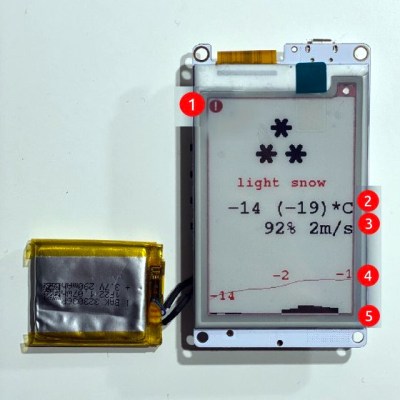Not that long ago, making a low-power and wireless weather display complete with an e-ink screen would have required a lot of work and almost certainly would have been larger than the device [Dmitry] created.

His low power e-ink weather gadget takes advantage of one of the niftier developer boards out there to create a useful and slim device that does exactly what he needs and not a lick more. It’s fast to look up weather online, but not as fast as glancing at a display in a convenient location.
The board [Dmitry] selected is a LilyGO TTGO T5s, an ESP32-based board that integrates an e-ink display, which requires no power unless being updated. It has been loaded with just enough smarts to fetch weather information using the OpenWeather API, and update the display accordingly.
Powering up the WiFi to fetch an easily-parsed JSON file and update the display only once per hour means that a battery can provide months of runtime. As a bonus, the LilyGO board even includes the ability to charge the battery, making things awfully convenient.
The bill of materials is here and code for the device, including setup directions, is on the project’s GitHub repository. And if your tastes happen to run more towards the artistic than utilitarian, we have just the weather display for you.
















–;
— not any real life power consumption data or runtime length data.
— not partial update feature
Who needs another “I bought a board, downloaded something and was able to upload it.” piece? Sorry.
Long runtime and partial update would be nice to see together (because GxIO is a piece of crap at that).
/me going to bed, bad mood.
If I were you, I’d attack you for being obvious.
Personally, I think this is pretty cool!
> a battery can provide months of runtime
My (pretty limited) knowledge/experience of/with the “LilyGO TTGO T5s” makes me think “probably not”.
100% agreed.
The reality is:
LilyGo TTOG T5 v2.2 ePaper + ESP32 Deep Sleep + 1000mAh Lipo
will give you a maximum of 6 days runtime if you wake it up once a day for 16 seconds for MQTT update.
This is very disappointing since I wanted to make it a routine to recharge the unit once a week say Sunday night.
I have upgraded with 2000mAh battery and it lasts about 10 days… now that fits for my purpose.
Have a look:
https://youtu.be/emR7AzLxxXU
I have done the exact same thing some while ago “weather screen with openweather”. TTGO has bad design in terms of power consumption, biggest consumers are leds and the w25q32fv spi flash that has the CS pin floating while MCU goes to sleep, a simple additional pullup on the CS pin drops the consumption to 1/10 or so. Still not ideal but you can get weeks instead of days of life out of battery.
Thanks!
TTgo has bad energy efficiency design, biggest easy fix is a pullup on w25q32 spiflash CS pin, without it spiflash does not go to sleep even when MCU is sleeping, this has a significant impact on sleep consumption. Removing all LEDs helps also.
Something is _very_ wrong there. Have you verified that the ESP32 is making it into deep sleep mode? If so, second port of call would be to make sure that it’s not running the eink drive all the time.
Or maybe that’s first — if the voltage boost converters were running all the time, and if they’re fairly leaky/inefficient, which is a good guess at that price point, that could slurp your batteries right down.
Or is there an LED on somewhere?
1000 mAh / 6 days = 7 mA. Even the ESP light sleep modes only draw 1 mA, which should get you weeks of runtime.
Just watched your video. It’s the green LED! Get rid of that sucker.
Awesome project, BTW. That’s a super clean installation, and I liked it even before I saw the picture frame rotate that first time!
Wow, that’s a good catch. Say that LED is at 7 mA and that it’s just current limited with a series resistor. The 1000 mAh LiPo Nomuza cited would be dead in 142 hours, or 6 days, from the LED alone.
Did pretty much the same project some while ago (openweather display + bus schedule). Found some flawed design on the board for battery operation. Biggest drain and easy to fix was the W25Q32 spi flash memory on board. Does not go to sleep with the MCU and drains plenty of power. Simple pullup on CS pin reduces consumption to fraction. Removing leds also helps.
In fact, T5s V2.8 might be more power-efficient than other boards in TTGO series. For starters, it does not have always-on LEDs. At the moment of writing, the board and software mentioned in the post is already working for 4 weeks on a single charge of 500mAh battery. It might be also related that in my setup board is located ≈2m from Wi-Fi.
I got one of the MagTags from Adafruit and use it as a weather display. It updates 4 times a day and lasts for two weeks on a 420 mAh battery.
https://www.adafruit.com/product/4800
Add the Dew Point temperature. Either download it from OpenWeather or calculate a close approximation from the ambient temperature and relative humidity[1].
References:
1. https://en.wikipedia.org/wiki/Dew_point